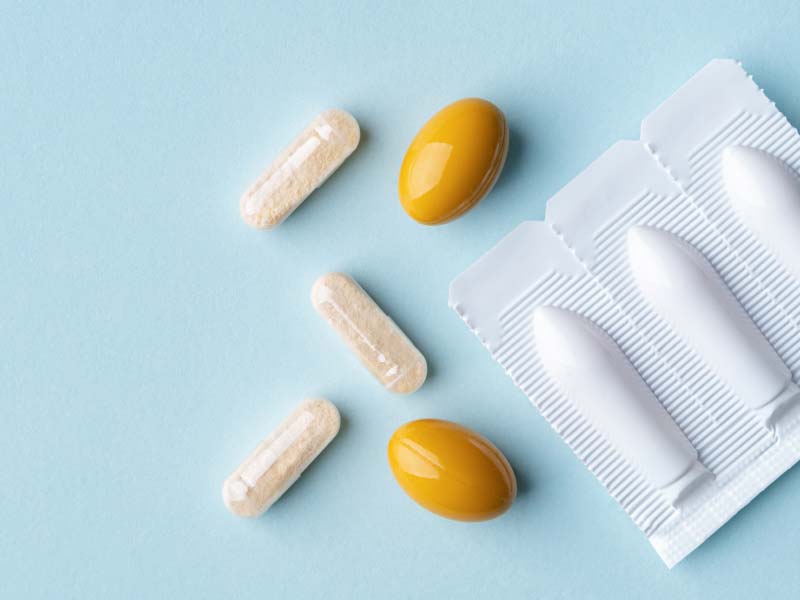
How to Test for Yeast Infections
at Home
Published on July 19, 2024
Updated on December 29, 2025
Written by Kathleen Morrison
Medically Reviewed by Andrea Sleeth WHNP-BC, MSCP
Key takeaways
- At-home yeast infection tests are a quick, low-stress way to figure out what’s going on down there—no awkward in-person waiting rooms, no overthinking, just clarity.
- pH strips, swab kits, and mail-in screenings all work a little differently, but they each give you helpful info about whether yeast might be the culprit behind your symptoms.
- Symptoms like itching, burning, redness, soreness, or thick white discharge are classic yeast infection vibes, especially if you’ve had one before and recognize the signs.
- At-home tests aren’t perfect (false results can happen), so if things feel off, symptoms stick around, or this is your first time dealing with it, chatting with a provider is always a smart move.
- If your test points to a yeast infection, you’ve got options: OTC antifungals, prescription treatments, or a provider-guided plan if symptoms are stubborn or keep coming back.
Yeast infections (also called thrush or vaginal Candidiasis, if you're feeling fancy) are super common. While they’re usually no big deal, they can definitely be annoying.
Knowing how to check for one from the comfort of your own home can give you some easy peace of mind and help you figure out what’s going on down there.
At-home testing is an easy and effective way to see if a vaginal yeast infection might be the culprit of whatever yuck you’re experiencing. The process is simple, and you don’t need any special skills or an in-person doctor’s visit to do it. When you pick up on any weird symptoms and get your test sorted at home, you’re taking control of your health and making sure you stay on top of things.
Can I test for a Yeast Infection at home?
Absolutely! At-home yeast infection testing is a super convenient way to check if your symptoms—like that annoying itch or unusual discharge—might be linked to a yeast overgrowth in the vagina.
These tests typically look at things like the pH level of your discharge or try to detect certain fungi that can cause yeast infections. But it’s important to know what these tests can and can’t do to make sure you’re using them the right way.
What at-home tests can (and can’t) do
At-home yeast infection tests are a great way to get a sense of whether a yeast infection might be causing your symptoms. They’re easy to use and interpret, so most people can do it without any stress. A super handy option is the Wisp Symptoms Quiz for some quick answers and clear next steps.
But here’s the thing: no test is perfect. Sometimes they might not give you a clear answer, and there’s always a chance for false results.
If your symptoms stick around or get worse after using the test or over-the-counter treatment, it’s time to reach out to a healthcare provider for some extra support.
When is an at-home test a good idea?
If you’re dealing with itching, burning, or discharge that feels off, testing at home could be a good idea—especially if you’ve had vaginal yeast infections before and are familiar with the signs:
- Itching or irritation around your vagina or vulva
- A burning feeling, especially when you pee or during sex
- Redness or swelling around the vulva
- Soreness or discomfort
- Thick, white discharge or vaginal fluid that kind of looks like cottage cheese (TMI, but still super normal)
You don’t need to check every box on the list to consider testing. Everyone’s experience is valid, and symptoms can range from barely-there to seriously annoying. If you’ve had fungal infections before, you might recognize the signs early and feel comfortable testing at home right away.
Just a heads-up: Some symptoms of a yeast infection are similar to other conditions, like bacterial vaginosis or certain STIs. If you’re not sure about your symptoms or this is your first time dealing with a yeast infection, it’s always smart to check in with a healthcare professional before jumping into self-diagnosis and treatment.
Easy ways to test for a Yeast Infection at home
Stop playing guessing games. At-home testing makes it easy to figure out what’s going on down there without the awkward in-person waiting room situation. Whether you're looking for something quick, detailed, or somewhere in between, there are a few easy methods.
Yeast infection test kits are available at pharmacies or online—and there are a bunch of different options!
Vaginal pH test strips
Let’s start with the basics: pH test strips. These little strips measure how acidic things are in your vagina—and changes in pH can give you a clue about what might be going on.
To use one, you gently press the strip against your vaginal wall for a few seconds, then match the color on the strip to the chart it comes with. If your vaginal pH level is above 4.5, it could mean something’s up—like bacterial vaginosis (BV)—but a pH below 4.5? That’s more in yeast infection territory.
But here's the thing: vaginal yeast infections don’t always cause pH changes, so if your results seem a little vague, don’t worry.
Vaginal swab test kits
Feeling ready to get a bit more specific? A vaginal swab test kit is another go-to option. You’ll usually get a cotton swab and a little testing device or solution in the kit.
Here’s how it works:
Pop the swab inside your vagina, give it a gentle spin (be brave, you’ll be fine), then follow the instructions in the kit. Depending on which one you’re using, you might dip the swab into a solution or plug it into a small testing gadget. Either way, results are usually ready in minutes—no guesswork, no stress.
These kits are great if you’re already familiar with your symptoms and want quick clarity without leaving your home.
Mail-in vaginal health screenings
If you’re the kind of person who likes a full report (charts, breakdowns, the works), a mail-in vaginal screening kit might be your new best friend. These offer a more in-depth look at your vaginal microbiome—aka, all the good and not-so-good bacteria living in your vagina.
Typically, you just collect a sample (usually with a swab or cup), send it to the lab, and get a detailed analysis of what's going on—including any signs of yeast or other imbalances.
A yeast infection test kit is a super helpful choice if you’ve been getting recurring infections, want more insight into your vaginal health, or just love a deep dive into your body’s signals. It’s like a report card for your vagina!
How long does a yeast infection test take?
If you’re staring at your symptoms and thinking, okay…what’s actually happening down there?, yeast infection testing is usually pretty quick and super straightforward, so it’s a no-brainer. Most at-home options give you answers really soon (within a few days or even hours), so you’re not stuck wondering for ages what’s going on.
If you’re using a rapid swab-style test, you’ll usually get results in just a few minutes. pH strips are even faster—dip, compare, done. They won’t always give you the full story, but they’re a helpful first step if you’re already familiar with your body and what “normal” feels like for you.
Mail-in tests take a little longer because your sample heads to a lab for a full workup. Most results come back within a few days from the lab receiving your results, and this option is ideal if you’re dealing with recurring symptoms, mixed signals, or you just want the most detailed picture possible.
And if you’re stuck between thinking you might have BV, a yeast infection, or something totally different, testing is always the way to go. An at-home BV + yeast test is a great choice when you’re unsure—especially if you’re juggling multiple symptoms and want clarity fast.
Step-by-step guide for taking your test
So you’ve got the tools, and now you’re ready to take matters into your own hands—literally. Testing for a yeast infection at home is way easier than it sounds, and with a little prep, you’ll be feeling confident, calm, and in control.
Getting set up
Before you start, take a sec to wash your hands—soap, water, the whole deal. You’re just keeping things clean so your test results are as accurate as possible.
Got a test kit? Give the instructions a once-over so you know what to expect (no surprises here!). If you can, try to test at a time when you haven’t had sex, used any vaginal products (like creams, tampons, or lube), or taken antibiotics in the past day or two. Morning is a great time to do it—before you shower, scroll, or get distracted.
How to use vaginal pH test strips
pH test strips are one of the simplest ways to get a quick read on what’s going on when it comes to vaginal infections. Here’s how to use them like a pro:
- Grab a strip from the package, but try not to touch the tip that does the testing—let it stay nice and ready.
- Gently press the test end against your vaginal wall for a few seconds.
- Let the strip work its magic (translation: change color).
- Compare the color to the little chart in your kit.
If your pH is above 4.5, something might be off—it could point to BV or another imbalance. A pH under 4.5? That’s more in the yeast infection zone. Still not sure? No stress. You can always retest or chat with a provider for backup.
How to collect and mail in your sample
Mail-in test kits are perfect if you’re craving more detailed insights or dealing with recurring symptoms and want to get to the bottom of things. They’re easy, discreet, and don’t require a lab coat.
Here’s how it usually goes:
- Use the swab (or cup, depending on the kit) to collect a small sample of vaginal discharge—don’t worry, it’s quick and painless.
- Pop your sample into the container they give you, then seal it up tight.
- Use the prepaid packaging to send it off to the lab. No lines, no awkward convos, just drop it off and carry on.
- Wait for your results, which usually land in your inbox in a few days.
Interpreting your test results
You did the test, and now you’ve got the results in hand. So… What does it all mean? Let’s decode it together—because understanding your body shouldn’t feel like reading an instruction manual written by a robot.
What your results are telling you
If your test came back positive for a yeast infection, that means there's probably a bit too much yeast hanging out in your vaginal microbiome. That can lead to super common (and super annoying) symptoms like itching, burning, or funky discharge.
If your result is negative, your symptoms might be pointing to something else—like BV or even an STI. And hey, just a quick note: at-home tests are great, but they’re not psychic. Sometimes results aren’t spot-on, and false positives or negatives can happen. Trust your gut (and your symptoms), and don’t hesitate to loop in a healthcare provider if something still feels off.
What to do next
If your test suggests a yeast infection, you’ve got plenty of ways to handle it. Most mild to moderate vaginal infections can be treated with over-the-counter antifungal medicines—think creams or suppositories you can grab at your local pharmacy. Easy peasy.
Still feeling off after a few days? Or maybe your symptoms are more intense than expected? This is your sign to reach out to a provider. You might need a prescription-strength treatment, or maybe even a quick check to rule out anything else that could be causing the drama downstairs.
Wisp treatment options are available only after consultation with a licensed medical professional. You should consult with your healthcare provider before starting a new supplement or treatment regimen. Individual results may vary.
When to check in with a provider (even if you tested at home)
There are moments when it's 100% okay to say, “You know what? I want someone to take a closer look.” Here’s when it might be time to chat with a provider:
- You used an over-the-counter treatment, but your symptoms are still crashing the party
- Yeast infections keep coming back (we’re talking four or more a year—rude)
- You’re dealing with more intense symptoms like serious redness, swelling, or sores
- You’re pregnant or have a health condition that makes your immune system extra sensitive
- You’ve never had a yeast infection before, and you’re not sure what’s going on
Basically, if something feels off or you're just not getting relief, you don’t have to figure it out solo. You deserve answers and a solution that works for your body.
What comes next after your test
Okay, so you’ve taken your test—go you! Whether you got a clear answer or you're still not 100% sure what’s going on, just know this: you’re already doing something amazing by tuning into your body and taking care of your vaginal health. That’s big. That’s powerful.
At-home testing can be super helpful for figuring out what’s up when something feels off. And once you understand how the test works, what your results mean, and when to reach out for extra support, you’re way ahead of the game. It’s like building your own personal playbook for feeling good down there (and everywhere else).
If your test results feel a little confusing, your symptoms aren’t going away, or you just want to double-check with someone who gets it, Wisp has your back. You can get prescription treatment, answers, and care without ever leaving your couch. Cozy and effective? Yes, please.
This blog post is for informational and educational purposes only and should not be taken as professional advice. Always consult with a qualified professional before making any decisions based on the information provided here.





